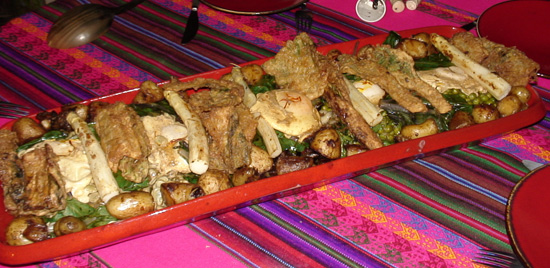End of August… Coco didledoo… the recipe of the real Provence Coco beans in anchovy cream and pesto
September 20th, 2009Artichoke choc-choc? Aubergine gigine? no … the bean, the one and only “haricot”, precious jewel of the Provence cuisine, has the priviledge of being named “Coco”… In case you are craving for the recipe just zap directly to the end. Otherwise…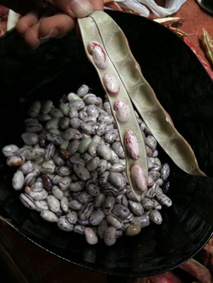
It has scared many more people already : Brillat Savarin, “Curse on the coco beans, curse the swamp beans …” (the physiologie of taste)… dull Northeners as well… An authentic “a meal of vilain”, the fair accomplice of garlic, anchovy and basil… of the late summer… the glory of never ending sun sets… a salvo to the belated pending pink flamingoes of the Salins de Giraud, still asking to themselves if it is really necessary to go back to Africa… the comfort of an ending sunny day in the Calanques of Marseille, battered by the Mistral wind, which, without telling, could not refrain from casting some of the chilly North Sea in the Méditerranean, … COCO…
COCO is not only a perfume… it is the ultimate artifice of the Adonis festival, for which all spices are getting sharpened, ready for a whole week of complete licence, all five senses at their extremes… women, husband, as you please… the 15th of August, festival of the virgins… pleasure without procuration, without procreation… decadent Rome, elegant Rome. Adonis has never been considered exactly as a politicaly correct company… but all ends in a burst of COCO beans, bean heads, bean brains… to harrypotter?… no! “Haricoter” : in Auvergne, center of France, it stands for ” to tear apart a piece of lamb”, as well as “to caress lovingly a woman”… the Auvergnat traditional dish is “the lamb haricot”… nothing to do with these poor fellows confined in their barracks, zealously left to their dry kidney beans . Same with the “Bean Hostal”; it used to be the nickname of the town prison and the “fayot” a bean head military who signs up for another go.
However in Catalogna, the fasting delicacy, is the mounjo, moungeta, moungete, mogett,… a nun… a nice little nunny; cant mistake with the COCO bean, can you? Although the “nun’s fart” is a standard traditional cake : an ivorish carnation under swelling veils, plumpy and generous, propitious to convert anybody. The Coco bean, on the contrary, is the poor man’s organ with it’s ever going exhalating happyness. Hilarious. Hi, that’s me. Take Five.
If Romans used it to put an end… to sublimate a whole week of orgie in order resume the everyday life… it is a Florentine woman, Catherine of Medicis, who made it famous. Her uncle of Pope, Clement the VIIth, former Jules of Medicis, has given monk Valeriano a sack of this COCO treasure, recently discovered in Peru, as dowry to Henri II and his queer court. The valeriane is a plant which excites cats, but make man sleep. The ecclesiastic canon Piero Valeriano was not exactly a wacky guy, but the plethorical germination of the coco bean truly made him jubilant; and indeed the multicolor jewels have been a real benediction for the famous sister of Alexander of Medicis.
“It was shown to me… a true little bean” Gasparine, Pot-Bouille, Zola, Nana… a dry bean lacks definitly the voluptuous curves, the almighty nude, love handed flesh of the cook bean. Worse, today’s master word is lean, quick, slim, slender… the GREEN bean has become the “New Look”, modern times’ credo, a boaring belief that turns women into fleshless anemic poor things.
“So let us seed until it is still time to,
Cause the bean song is one of the shortest”
Sings Georges Guétary in Florished Road of Francis Lopez. Olé! Besitos.
The Recipe :
Ingredients : coco beans, veggies, spices, and an anchoiade base (anchovy paste).
Options : poutargue or basil, make your choice.
A piece of advice : to be prepared before going to bed for the next day.
Onion sofrito with garlic and veggies : On Arles’ market we have organic “Thai aubergines”, “snake zucchinies”, ” Royal Thai basil with citronnella at the Laosian stand. 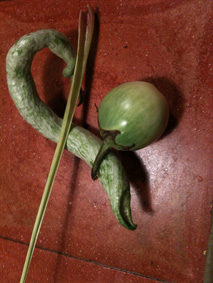 Yes we are lucky. The sofrito, always with olive oil. May I remind you that the best olive oil in France is the one of Montfrin castle, gold medal 2006&2008 of the general agriculture competition, distilled by the great Jean René de Fleurieu … excellent.
Yes we are lucky. The sofrito, always with olive oil. May I remind you that the best olive oil in France is the one of Montfrin castle, gold medal 2006&2008 of the general agriculture competition, distilled by the great Jean René de Fleurieu … excellent.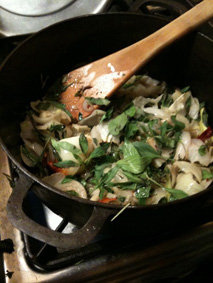
The coco bean does not mingle with the mediocre. When the sofrito is done : throw the beans. Water, the less calcar possible. Cover, cuddle. slight fire, inexistant, protct it fro the flames with thick diffuser. At a slight boil, you have the shakes. Stop. The best is to use a thick iron pot to keep the heat longer and slow. Slowly my sweety coco. It is 3 O’clock in the morning, turn off everything. Cover. Next morning, you release the cover. Yummy. What a nice day. Give a little heat. Not too much.
Back in the evening . The serious job starts: according to your mind, crush a handfull of basil, or lard micrometric slices of Poutargue, the dry fish row from Martigues. Once your spirits recovered, grab a sauce pan, crushed garlic and olive oil. Put the juice of the coco with a Mexican chipotle chile.
Now the anchovy paste: dilute and emulsionate in the sauce. It will be the salt of your COCOs. Off the fire. A big breath and when you feel it is not too warm anymore mix 2/3 of the fresh basil or the poutargue. Serve while spreading the remaining 1/3. (without eating the poutargue hiding, bean head…)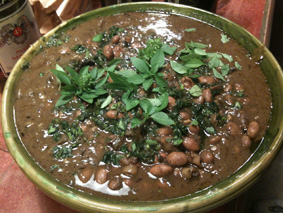
Sorry I could not refrain…
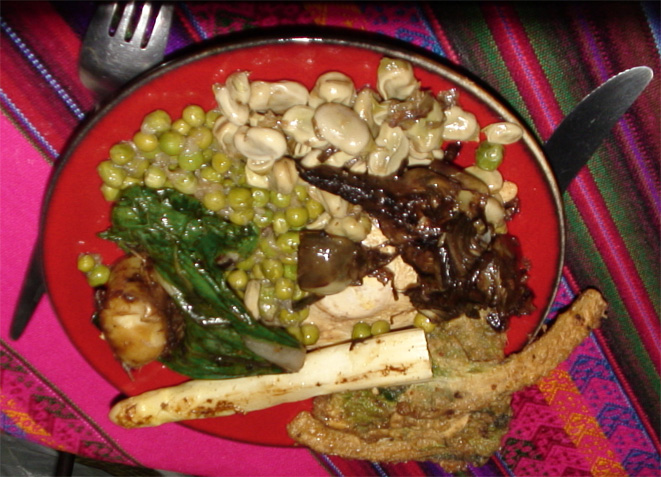 At last Spring has arrived in our plates, in this night of May .
At last Spring has arrived in our plates, in this night of May .